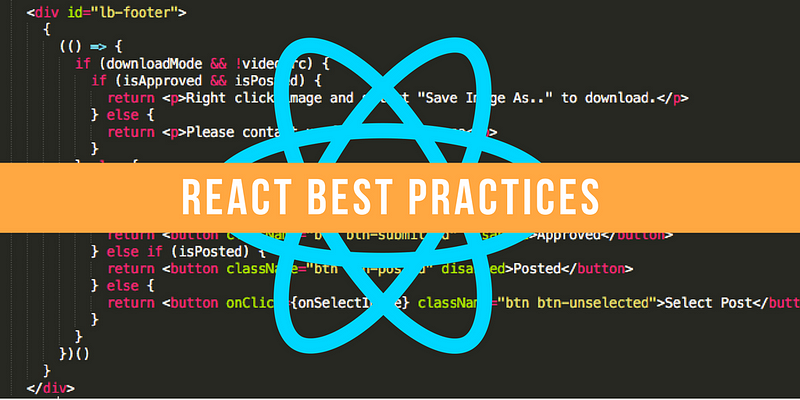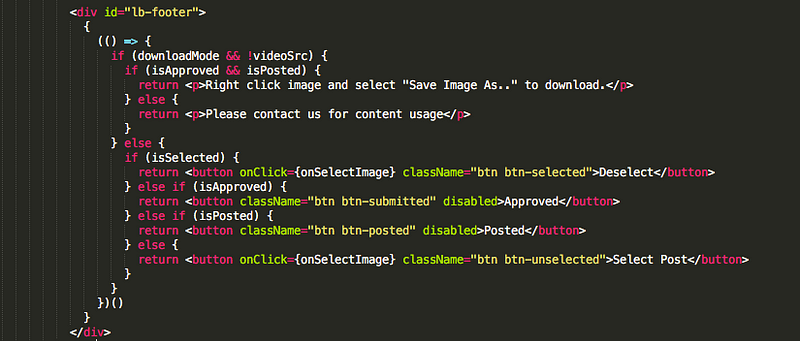- 原文作者:Scott Domes
- 译文出自:掘金翻译计划
- 译者:imink
- 校对者:L9m、Professor-Z
编写 React 组件的最佳实践

当我一开始写 React 的时候,我记得有许多不同的方法来写组件,每个教程都大不相同。虽然从那以后 React 框架已经变得相当的成熟,但似乎仍然没有一种明确的写组件的“正确”方式。
过去一年在 MuseFind 工作中,我们的团队写过了无数的 React 组件。我们也在不断的改善方法直到我们满意为止。
这篇指南是我们建议的编写 React 组件的最佳方式。不管你是初学者还是有经验的人,我们希望它对你有用。
在开始之前,一些注意事项:
- 我们使用 ES6 和 ES7 语法。
- 如果你还不清楚展示组件和容器组件,我们建议先读这篇.
- 请不吝评论,留下你的建议和问题以及反馈。
基于类的组件
基于类的组件包含了状态和方法。我们应该尽量保守的去使用它们,但是这类组件有他们的用武之地。
接下来,我们来逐行地构建我们的组件
引入 CSS
import React, {Component} from 'react'
import {observer} from 'mobx-react'
import EexpandableFormRequiredPropsxpandableForm from './ExpandableForm'
import './styles/ProfileContainer.css'
我理论上比较倾向 CSS in JavaScript,但是这还是一个比较新的想法,到目前为止并没有一个相对成熟的解决方法出现。所以目前,我们对每一个组件都引入 CSS 文件。
我们用空行把本地引入和依赖引入分开。
初始化状态
import React, {Component} from 'react'
import {observer} from 'mobx-react'
import ExpandableForm from './ExpandableForm'
import './styles/ProfileContainer.css'
export default class ProfileContainer extends Component {
state = { expanded: false }
如果你使用 ES6 而不是 ES7,请在构造方法里初始化状态。除此之外,你可以在 ES7 中使用上面的方法初始化状态。更多信息,请移步这里。
当然,我们还需将我们的类作为默认类导出。
propTypes 和 defaultProps
import React, {Component} from 'react'
import {observer} from 'mobx-react'
import ExpandableForm from './ExpandableForm'
import './styles/ProfileContainer.css'
export default class ProfileContainer extends Component {
state = { expanded: false }
static propTypes = {
model: React.PropTypes.object.isRequired,
title: React.PropTypes.string
}
static defaultProps = {
model: {
id: 0
},
title: 'Your Name'
}
propTypes 和 defaultProps 是静态的属性,需要尽可能早的在组件代码中声明。因为它们是作为文档而存在的,所以当其他开发者在阅读代码时候,它们应该尽早被看到。
所有的组件都应该有 propTypes。
方法
import React, {Component} from 'react'
import {observer} from 'mobx-react'
import ExpandableForm from './ExpandableForm'
import './styles/ProfileContainer.css'
export default class ProfileContainer extends Component {
state = { expanded: false }
static propTypes = {
model: React.PropTypes.object.isRequired,
title: React.PropTypes.string
}
static defaultProps = {
model: {
id: 0
},
title: 'Your Name'
}
handleSubmit = (e) => {
e.preventDefault()
this.props.model.save()
}
handleNameChange = (e) => {
this.props.model.name = e.target.value
}
handleExpand = (e) => {
e.preventDefault()
this.setState({ expanded: !this.state.expanded })
}
在基于类的组件中,当你需要向子组件传递方法的时候,你应该确保他们被调用的时候正确地绑定了 this。通常可以由 this.handleSubmit.bind(this) 传递给子组件来实现。
我们认为这种方法更简洁易用,通过 ES6 的箭头函数来自动确保正确的上下文。
解构 Props
import React, {Component} from 'react'
import {observer} from 'mobx-react'
import ExpandableForm from './ExpandableForm'
import './styles/ProfileContainer.css'
export default class ProfileContainer extends Component {
state = { expanded: false }
static propTypes = {
model: React.PropTypes.object.isRequired,
title: React.PropTypes.string
}
static defaultProps = {
model: {
id: 0
},
title: 'Your Name'
}
handleSubmit = (e) => {
e.preventDefault()
this.props.model.save()
}
handleNameChange = (e) => {
this.props.model.name = e.target.value
}
handleExpand = (e) => {
e.preventDefault()
this.setState(prevState => ({ expanded: !prevState.expanded }))
}
render() {
const {
model,
title
} = this.props
return (
<ExpandableForm
onSubmit={this.handleSubmit}
expanded={this.state.expanded}
onExpand={this.handleExpand}>
<div>
<h1>{title}</h1>
<input
type="text"
value={model.name}
onChange={this.handleNameChange}
placeholder="Your Name"/>
</div>
</ExpandableForm>
)
}
}
有多个 props 的组件应该每行只写一个 prop,就像上面一样。
装饰器
@observer
export default class ProfileContainer extends Component {
如果你使用了像mobx的工具,你可以像上面这样来装饰组件,这和把组件传递到函数一样。
装饰器 是一种灵活可读的用来修饰组件功能的方法,配合 mobx 和 我们自己的 mobx-models 库,我们可以广泛的应用这种方法。
如果你不想使用装饰器,可以这么做:
class ProfileContainer extends Component {
// Component code
}
export default observer(ProfileContainer)
闭包
避免向子组件传递新的闭包,比如:
<input
type="text"
value={model.name}
// onChange={(e) => { model.name = e.target.value }}
// ^ Not this. Use the below:
onChange={this.handleChange}
placeholder="Your Name"/>
原因在此:每次父级组件渲染的时候,一个新的函数就会被创建,传递到 input 中。
如果这里的 input 是一个 React 组件,这会自动触发该组件重新渲染,不管该组件当中的 props 有没有被改变。
子级校正 (Reconciliation) 是 React 框架中最耗资源的部分。如果不需要,就不要增加难度。而且传递一个类方法会使代码更易于阅读,易于调试,易于修改。
以下是组件的全貌:
import React, {Component} from 'react'
import {observer} from 'mobx-react'
// Separate local imports from dependencies
import ExpandableForm from './ExpandableForm'
import './styles/ProfileContainer.css'
// Use decorators if needed
@observer
export default class ProfileContainer extends Component {
state = { expanded: false }
// Initialize state here (ES7) or in a constructor method (ES6)
// Declare propTypes as static properties as early as possible
static propTypes = {
model: React.PropTypes.object.isRequired,
title: React.PropTypes.string
}
// Default props below propTypes
static defaultProps = {
model: {
id: 0
},
title: 'Your Name'
}
// Use fat arrow functions for methods to preserve context (this will thus be the component instance)
handleSubmit = (e) => {
e.preventDefault()
this.props.model.save()
}
handleNameChange = (e) => {
this.props.model.name = e.target.value
}
handleExpand = (e) => {
e.preventDefault()
this.setState(prevState => ({ expanded: !prevState.expanded }))
}
render() {
// Destructure props for readability
const {
model,
title
} = this.props
return (
<ExpandableForm
onSubmit={this.handleSubmit}
expanded={this.state.expanded}
onExpand={this.handleExpand}>
// Newline props if there are more than two
<div>
<h1>{title}</h1>
<input
type="text"
value={model.name}
// onChange={(e) => { model.name = e.target.value }}
// Avoid creating new closures in the render method- use methods like below
onChange={this.handleNameChange}
placeholder="Your Name"/>
</div>
</ExpandableForm>
)
}
}
函数组件
这部分组件没有状态和方法。此类组件比较纯粹,易于理解。尽量多使用这类组件。
propTypes
import React from 'react'
import {observer} from 'mobx-react'
import './styles/Form.css'
const expandableFormRequiredProps = {
onSubmit: React.PropTypes.func.isRequired,
expanded: React.PropTypes.bool
}
// Component declaration
这里,我们在文件最开始给变量赋值 propTypes,所以它们立即可见。在下面的组件声明中,我们来更恰当地赋值。
解构 Props 和 defaultProps
import React from 'react'
import {observer} from 'mobx-react'
import './styles/Form.css'
const expandableFormRequiredProps = {
onSubmit: React.PropTypes.func.isRequired,
expanded: React.PropTypes.bool
}
function ExpandableForm(props) {
return (
<form style={props.expanded ? {height: 'auto'} : {height: 0}}>
{props.children}
<button onClick={props.onExpand}>Expand</button>
</form>
)
}
我们的组件是一个函数,其中 props 作为参数。我们可以像下面这样把它展开:
import React from 'react'
import {observer} from 'mobx-react'
import './styles/Form.css'
const expandableFormRequiredProps = {
onExpand: React.PropTypes.func.isRequired,
expanded: React.PropTypes.bool
}
function ExpandableForm({ onExpand, expanded = false, children }) {
return (
<form style={ expanded ? { height: 'auto' } : { height: 0 } }>
{children}
<button onClick={onExpand}>Expand</button>
</form>
)
}
注意我们可以通过更可读的方式来使用默认参数作为 defaultProps。如果 expanded 没有被定义,我们设定它为 false。(一种更合理的解释是,虽然它是布尔类型,但是可以避免出现 ‘Cannot read < property > of undefined’ 此类对象错误的问题)。
避免使用如下的 ES6 语法:
const ExpandableForm = ({ onExpand, expanded, children }) => {
看起来非常得时髦,但这里的函数实际上未命名。
如果Babel设置正确,这里未命名不会造成问题。但是如果Babel设置错了的话,任何错误都会以 << anonymous >> 的方式呈现,这对于调错是非常糟糕的体验。
未命名的函数也可以会伴随 Jest (一个 React 测试库)出现问题。由于这些难以理解的 bugs 的潜在问题,我们建议使用 function 代替 const.
封装
既然你不能对函数组件使用装饰器,你可以把函数作为参数传递过去。
import React from 'react'
import {observer} from 'mobx-react'
import './styles/Form.css'
const expandableFormRequiredProps = {
onExpand: React.PropTypes.func.isRequired,
expanded: React.PropTypes.bool
}
function ExpandableForm({ onExpand, expanded = false, children }) {
return (
<form style={ expanded ? { height: 'auto' } : { height: 0 } }>
{children}
<button onClick={onExpand}>Expand</button>
</form>
)
}
ExpandableForm.propTypes = expandableFormRequiredProps
export default observer(ExpandableForm)
以下是组件的全貌:
import React from 'react'
import {observer} from 'mobx-react'
// Separate local imports from dependencies
import './styles/Form.css'
// Declare propTypes here as a variable, then assign below function declaration
// You want these to be as visible as possible
const expandableFormRequiredProps = {
onSubmit: React.PropTypes.func.isRequired,
expanded: React.PropTypes.bool
}
// Destructure props like so, and use default arguments as a way of setting defaultProps
function ExpandableForm({ onExpand, expanded = false, children }) {
return (
<form style={ expanded ? { height: 'auto' } : { height: 0 } }>
{children}
<button onClick={onExpand}>Expand</button>
</form>
)
}
// Set propTypes down here to those declared above
ExpandableForm.propTypes = expandableFormRequiredProps
// Wrap the component instead of decorating it
export default observer(ExpandableForm)
JSX 中的条件语句
如果你要使用很多有条件限制的渲染,这里是你需要避免的:

内嵌套的三元运算符不是一个好想法。
虽然有一些第三方的库解决这个问题(JSX-Control Statements),但这里我们用下面的方法来解决复杂的条件语句,而不去引用这些依赖。

使用花括号包装一个 IIFE,然后把 if 语句放进去,返回你想渲染的任何东西。注意 IIFE 可能会导致性能问题,但是在绝大多数情况下,它导致的性能问题还不足以与代码可读性问题相比。
同样,当你只想在一个条件语句中渲染某个元素,不要这么做:
{
isTrue
? <p>True!</p>
: <none/>
}
应该使用短路求值(short-circuit evaluation)的方式
{
isTrue &&
<p>True!</p>
}
完